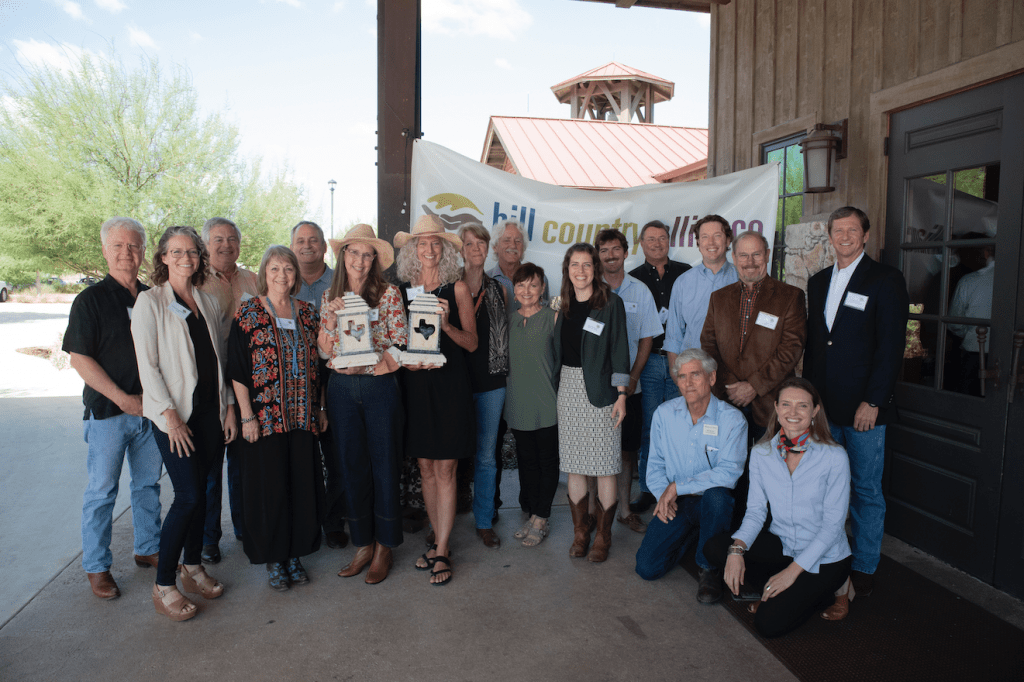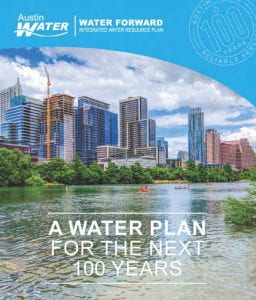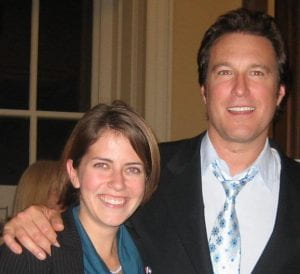Executive Director of the Hill Country Alliance
In this issue’s Q&A, Texas+Water Editor-in-Chief, Dr. Todd Votteler, interviews Katherine Romans, Executive Director of the Hill Country Alliance, a regional nonprofit focused on protecting the water, land, communities and night skies of the Texas Hill Country. She has more than a decade of nonprofit and legislative experience in natural resource issues and holds a Master of Environmental Management from the Yale School of Forestry and Environmental Studies. Romans serves on the board of the Hill Country Land Trust and is the inaugural chair of the Texas Hill Country Conservation Network steering committee.
What is the mission and history of the Hill Country Alliance (HCA)?
 The Hill Country Alliance was founded 14 years ago by a group of neighbors concerned about unplanned and unmanaged growth in western Travis County, just outside of Bee Cave, Texas. These neighbors knew firsthand what prolific development meant for the resources that define the Hill Country. They had seen creeks choked with sediment and construction runoff, their view of the Milky Way clouded by light pollution, and the scenic vistas of their neighborhood transformed overnight by new rooftops and billboards.
The Hill Country Alliance was founded 14 years ago by a group of neighbors concerned about unplanned and unmanaged growth in western Travis County, just outside of Bee Cave, Texas. These neighbors knew firsthand what prolific development meant for the resources that define the Hill Country. They had seen creeks choked with sediment and construction runoff, their view of the Milky Way clouded by light pollution, and the scenic vistas of their neighborhood transformed overnight by new rooftops and billboards.
From day one, HCA has focused on creating a vision for the Hill Country we will hand down to future generations. With innovation, leadership, and community, we know that we can accommodate the growth coming to Central Texas while protecting our natural resources, rather than undermining them. From our grassroots beginnings, our organization has grown to work across 17 counties of Central Texas, from Austin to San Antonio, Uvalde, Junction and Mason.
Our mission is to bring together an ever-expanding alliance of groups throughout a multi-county region of Central Texas with the long-term objective of preserving open spaces, water supply, water quality and the unique character of the Texas Hill Country. It’s a big objective, but we certainly aren’t alone in our work. Every victory is a reflection of the incredible leadership of the organizations, businesses, landowners, volunteers and elected officials we work with throughout this region.

What are some of HCA’s most significant accomplishments?
We have a lot to be proud of in our work over the past 14 years. We have grown tremendously as an organization, from a single full-time executive director to a staff of seven. Our supporter list across the region is 10,000 strong, and we have deep connections to local community members, volunteers, and elected officials from every corner of the Hill Country. We are seen as a regional convener, a trusted idea broker, and a thought leader. Groups from other parts of Texas and the country are looking at the collaborative efforts in the Hill Country as models to replicate.
Thanks to HCA’s work, 13 of the 17 counties of our region have passed resolutions supporting the night skies. Just this month we saw the formalization of a groundwater conservation district in southwest Travis County—something we and our partners have been pushing for more than a decade. We connect annually with more than a thousand landowners to provide technical support and access to stewardship and financial resources. We have seen monumental investments in land conservation over the past 14 years—from Austin and Travis County to Hays County and San Antonio. We are providing critical capacity to emergent organizations and coalitions, including the many organizations that have formed within the past few years to oppose the growing aggregate industry in the Hill Country.
None of these accomplishments were achieved alone. HCA is only as strong as our network of partners, working collaboratively to share lessons learned, increase our impact, and improve our effectiveness for the future of the Hill Country. Most recently, HCA has been serving as a backbone organization for the Texas Hill Country Conservation Network (the Network), a new initiative that has elevated our collaboration even further by engaging 75 nonprofit and governmental partners in a more formal structure with a shared strategic plan and six actionable goals.
The Network has generated huge momentum, and allowed us to draw national attention and funding into conservation in Central Texas. In September, a consortium of foundations, called the Water Funder Initiative, selected the Texas Hill Country Conservation Network as one of five campaigns nationwide through which it will be channeling time, energy and funding resources to promote transformative water work. We plan to leverage this investment for significant water conservation successes on the ground.

What are the HCA’s major programs?
Since the beginning, the Hill Country Alliance’s primary activity has been to bring neighbors together to share information about current challenges relating to growth and development in the Texas Hill Country, and to find innovative alternatives to business-as-usual development. Within the past few years, we have honed our strategic focus and aligned our work within the region across four major program areas—Land, Water, Night Skies and Community.
Water: Thirteen Texas rivers begin in the Hill Country and provide water for millions of downstream neighbors. As our region grows, our demands on limited aquifer resources threaten to dry up wells and springs that support the creeks and rivers of the Hill Country. We work across multiple scales to ensure we are managing surface water and groundwater for the long-term health of our region.
Land: Texas is losing heritage ranch lands faster than any other state in the country. As ranch lands are divided and urban development pushes further into the rural Hill Country, we are losing pieces of our rural heritage, wildlife habitat, healthy watershed function, open spaces and scenic vistas – the very things for which the region is known and loved. HCA combats land fragmentation and degradation by promoting both land conservation and good land stewardship.
Night Sky: Eight out of ten children will grow up unable to see the Milky Way due to light pollution. As development pushes westward from the urban corridor, we are losing our view of the night sky that once inspired a songwriter to croon, “The stars at night are big and bright, deep in the heart of Texas.” HCA convenes diverse groups of stakeholders and community leaders to raise awareness and adopt policies that slow the spread of light pollution and the degradation of Hill Country night skies.
Community: Ninety percent of Hill Country lands are in unincorporated where there is little county authority to plan for growth. Unprecedented growth is diluting the heritage of our rural towns with sprawling development patterns that take away from courthouse squares and main streets. HCA promotes new and better ways to grow healthy, vibrant communities both in the urban corridor and in rural areas throughout the region. We work to bring communities together around shared values, promote reasonable policies to address the impacts of sprawl, and support leaders throughout the region who are working to ensure the Hill Country remains a special, natural place for future generations.
Are the groundwater and surface supplies of the Hill Country sufficient to support the growing population while ensuring a healthy and sustainable environment?
Not as we currently manage them. As a state, we have issued more surface water permits than we have water in our rivers. We are managing our aquifers for their depletion. If we continue to develop and use water like we do today, we will overdraw our current supplies of both surface water and groundwater—causing huge ecological harm to our environment and ultimately ruining our economic future as a region, which depends on resilient water supplies.
The good news is that we don’t have to develop and use water like we do today. In some Hill Country communities, as much as 50% of our clean, potable drinking water supply goes to watering lawns during the summer months. If we address our demand for water (distinguish between our water “wants” versus water “needs”), and simultaneously look for strategic ways to capture and reuse water, essentially adding new sources to our water supply, we absolutely can accommodate a growing population.

There are great examples of communities that are doing just that—addressing the challenges of reducing our demand for water while diversifying our water supply. For example, the City of Austin recently approved a cutting edge 100-year water plan, called Water Forward.
The plan addresses climate change and its impacts on our water supply, considers new sources of water (e.g. capturing rainwater and air conditioning condensate), and envisions a holistic approach to ensuring that the city is actually generating additional water resources as it grows.
The Permian Highway Pipeline has been a major source of controversy. Has opposition to the pipeline united the Hill Country in a way that it was not unified before? Has it resulted in more discussion about the Hill Country’s future?
The Permian Highway Pipeline (PHP) project has absolutely ignited a movement, not just within the Hill Country but across the entire state of Texas. This 42-inch natural gas pipeline would be the first major oil and gas industry infrastructure to be routed across the Hill Country in half a century. As planned, the PHP would cross working ranchlands, through rapidly growing communities such as Kyle in Hays County, and across critical natural resources—including golden cheeked warbler habitat, the recharge zone of the Edwards Aquifer, as well as the Llano, Pedernales, and Blanco Rivers and their tributary creeks. We have seen cities, counties, school districts, landowners, nonprofits and groundwater conservation districts unified in their opposition to this project, and the impacts it could have on our region.
Regardless of your feeling of whether the Hill Country is the right place for a pipeline of this size, there is a growing realization that the scales are heavily weighted in favor of the pipeline industry, at the expense of landowners and communities across this state. It is far too easy for an oil and gas pipeline company—a private, for-profit entity—to file paperwork with the Texas Railroad Commission to be a common carrier and receive the privilege of eminent domain. Routing decisions are made behind closed doors, and landowners often only become aware of the project when they receive formal letters from the industry mentioning condemnation. Unlike the routing process for a transmission line, which goes before an independent third body, the Public Utility Commission, there is no state oversight for the routing of oil and gas pipelines. HCA is part of a growing coalition of landowner organizations, governmental entities and nonprofits joining forces to demand oversight and community participation in the routing process in the future.
Is it the Hill Country’s destiny to become the Texas version of the California wine country?
Whether we love it, hate it, or take advantage of it every weekend, it seems the wine industry is here to stay in the Hill Country. Not only are there new wineries opening every month (by latest count, there are more than 80 vineyards in the region between Johnson City and Fredericksburg alone), Texas wineries are gaining national recognition for the quality of the wines they are producing—meaning the Hill Country is only going to grow into its reputation as the “Napa of Texas.”
What is wonderful about the wine industry in the Hill Country is that these wineries have a vested interest in protecting the natural resources of our region. The scenic vistas, prolific aquifers, clear creeks and dark skies are all part of the experience of escaping to a Hill Country vineyard tasting room or porch to sip a delicious glass of wine. Wineries, and agritourism more broadly, are dependent on maintaining our region’s rural charm and the vitality of our natural resources. That makes the wine industry a natural ally for the conservation community.

What previous experience has been most valuable to you as HCA’s Executive Director?
For four years I worked as a legislative aid within the U.S. House of Representatives, for the Committee on Natural Resources. That job was great training for the breadth of issues I manage on a day-to-day basis at HCA. Serving as the Executive Director for a nonprofit, you become a jack of all trades. There are days when I bounce from landowner workshops to policy conversations, to HR, tech support and website management, event planning and communications strategy. The fast pace and compelling nature of the work keep me motivated even when the days are long and tough.
What do you enjoy most about your work as HCA’s Executive Director?
I absolutely love HCA’s role as a convener and collaborator, and I think our founding Executive Director, Christy Muse, did a beautiful job of baking that into the foundational fabric of this organization. I believe firmly that we are only as strong as our Network of partners. Our successes are always shared among multiple organizations, and I have worked hard to continue fostering that collaborative spirit. Forming working partnerships with such a broad, diverse, and passionate group of individuals and organizations has been hugely impactful to me professionally.

